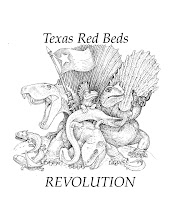School is out for the day, and I am cutting across a stretch of grass, cactus and mesquite trees, headed out to join the rest of the HMNS team. I kneel on the ground next to David Temple, who is marveling over a giant vertebra he just found and I smile, because just a few months ago, I would have looked at this slope of rocks and seen just that. Rocks. But ever since I got into paleo, I see a lot more than just a rock. I see a time span of millions and millions of years. I see a Lysorophus curled up into a ball, waiting for rains that never came. I also see classrooms full of students, throwing more questions at me than I can possibly answer in one 45-minute class period.
Welcome to paleontology, where few things are really all that they seem.
As a high school science teacher, I know from experience that there are a lot of chapters in a text book that are a lot like rocks. You move over and around them everyday, not even knowing to look for something fascinating that might be hiding under the surface of a chapter title like “Chapter One: Scientific Method.” I know from experience that sometimes the difference between a kid learning something and not even trying is simply a matter of presentation. So when I saw that lesson about steps for scientific method coming, I thought I might try something that my students surely hadn’t seen before.
I brought them a rock.
But not just any rock. I brought them a rock that I had found myself. I told them where I found it and I told them that I honestly had no idea about what it was when I picked it up (step one: state the problem!!). I asked for ideas (or dare I say “hypotheses”?) about what this rock could be and then I told them how I actually gathered information (step two!) about each one of those ideas. Then we tested each of those ideas together (step three!). I told them that the test that gave me the most information was actually sticking my tongue to the rock and when it stuck, I knew I had bone (paleontologists can be quite efficient!). “A bone?! But what kind of bone?! How did it get there??!” my students asked me in surround sound, and before I knew it, a room full of what used to be bored kids was now analyzing results and drawing conclusions with an enthusiasm that caught even me off guard. Scientific method suddenly made sense, now that we weren’t looking at it with glazed-over eyes.
With one rock – or chunk of mammoth tusk – I had stumbled upon a way to let kids get carried away in discovering what science really is. Don’t you see? Science is actually a world that is relevant to us, full of mystery and puzzle pieces just waiting to be put together.
Not just a rock.
Welcome to paleontology, where few things are really all that they seem.
As a high school science teacher, I know from experience that there are a lot of chapters in a text book that are a lot like rocks. You move over and around them everyday, not even knowing to look for something fascinating that might be hiding under the surface of a chapter title like “Chapter One: Scientific Method.” I know from experience that sometimes the difference between a kid learning something and not even trying is simply a matter of presentation. So when I saw that lesson about steps for scientific method coming, I thought I might try something that my students surely hadn’t seen before.
I brought them a rock.
But not just any rock. I brought them a rock that I had found myself. I told them where I found it and I told them that I honestly had no idea about what it was when I picked it up (step one: state the problem!!). I asked for ideas (or dare I say “hypotheses”?) about what this rock could be and then I told them how I actually gathered information (step two!) about each one of those ideas. Then we tested each of those ideas together (step three!). I told them that the test that gave me the most information was actually sticking my tongue to the rock and when it stuck, I knew I had bone (paleontologists can be quite efficient!). “A bone?! But what kind of bone?! How did it get there??!” my students asked me in surround sound, and before I knew it, a room full of what used to be bored kids was now analyzing results and drawing conclusions with an enthusiasm that caught even me off guard. Scientific method suddenly made sense, now that we weren’t looking at it with glazed-over eyes.
With one rock – or chunk of mammoth tusk – I had stumbled upon a way to let kids get carried away in discovering what science really is. Don’t you see? Science is actually a world that is relevant to us, full of mystery and puzzle pieces just waiting to be put together.
Not just a rock.

1 comment:
hey mrs beck just here checking out your site its really interesting i love your ways of telling us how science is different in many ways thanks a lot
xoxoxox
mariana and neddy
Post a Comment